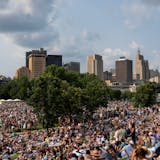A change in state law enacted in 2019 gave cities the ability to set speed limits on streets under their jurisdiction after conducting a study, without having to get permission from the Minnesota Department of Transportation.
In the years that followed, Minneapolis, St. Paul and several metro area suburbs took advantage and dropped speed limits from the statutory speed of 30 mph to 25 mph or even 20 mph. But have they been effective in slowing down drivers?
“The jury is still out,” said Gary Davis, a professor in the Civil, Environmental and Geo-Engineering Department at the University of Minnesota. “If you change signs but don’t do any other changes, what effect does that have on how fast a driver is going?”
Davis and researchers from the U’s Center for Transportation Studies teamed up with St. Louis Park to carry out a before-and-after study. Both the city and the U looked at how fast motorists drove on residential streets before the west metro suburb reduced speed limits in 2021, and after new signs went up.
St. Louis Park also handed out more than 600 lawn signs that read “20 is Plenty” over a two-year period and placed portable electronic speed boards throughout the city to augment efforts to educate drivers about lower speed limits.
Results showed motorists generally drove faster than the newly posted speed limits, with the lowest level of compliance on streets that were signed at 20 mph, Davis said. But overall speeds across the city — including on streets where the speed limit did not change — decreased by 1 to 2 mph. The average speed of most drivers in the west metro suburb is now within 5 mph of the posted speed limit, the study found.
“It was a slight reduction,” St. Louis Park engineering project manager Jack Sullivan said in a webinar discussing the topic. “We are trending in the right direction.”
Studies show there is little change in speed patterns after a lower speed limit is posted. Drivers are much more influenced by changes to the roadway, its environment and conditions, the Minnesota Department of Transportation said.



